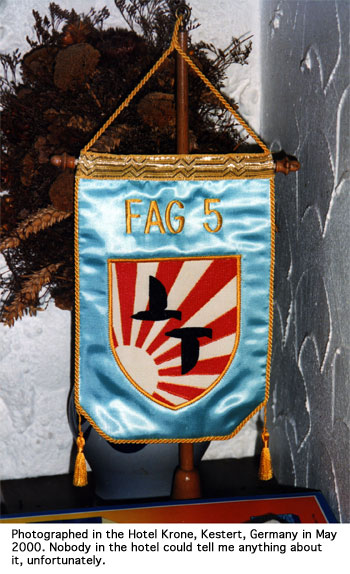 |
||
|
On 1 March, Luftwaffe General Denmark proposed moving Stab FAG 1 up to Grove; he also wanted to move 1.(F)/5 from Neubiberg to the same airfield and to subordinate it to FAG 1. Gen.d.A. responded by telegram next day and the upshot was that Stab FAG 1 moved to Wittmundhafen on the 9th.
On 2 March, an Arado of 1.(F)/123 flew a reconnaissance check on the Humber Estuary and took photographs of Hull. The Staffel was ordered to cover harbours from Hull to Dover again the next day target but confirmation that it did so is lacking. In any event, another unit would now take on the task. The British Air Operational Watch for the next day noted that “an Ar 234 was again to make a flight from Stavanger” but offered no further detail. On 4 March Gen.d.A. noted that reconnaissance Ar 234s would be ready for operations from Stavanger in six days’ time: U-boat command was to pass requests for coverage direct to Luftwaffe General Norway. On the 6th an Ar 234 took off from Stavanger at 08.45 GMT for a non-operational flight northward. Meanwhile that day, Luftwaffenkommando West instructed that 1.(F)/33 (at Wittmundhafen, under Luftwaffe General Denmark) would be covering the harbours, convoy routes and ground organisation of south eastern England “beyond the southern recce boundary as far as London inclusive [and therefore] all 1.(F)/123’s special tasks concerning recce of England” would lapse. The 1.(F)/33’s new CO was Hptm. Heinz Hattan, appointed on 26 February by swapping places with Hptm. Hermann Holert who succeeded Hattan as Kapitän of 1.(F)/100. On 17 March however, Gen. der Aufklärungsflieger's diary noted: "Hptm. [Christian] Jährig, 3.(F)/123, to 1.(F)/33 as Staffelkapitän."
It is not clear whether the 10 March deadline for operations was met but the first missions from Norway that the Allies learned of were flown on the 23rd. Two Ar 234s took off at 13.50 and landed at 16.10 and 16.12 hours. The machine assigned the “southern task” was able to secure photos of the coastal waters from the Firth of Forth down to South Shields and sighted miscellaneous shipping between Dundee and the latter town. The “northern task” was allocated to Hellmut Hetz, his 9V+AH (W.Nr. 140341) needing drop tanks to make the range and rocket assistance to get it into the air. He made landfall north of Aberdeen and made his way towards the Firth of Forth but the Arado developed a fuel leak and an engine overheated, leading to a forced landing at base in which he was badly hurt and the aircraft heavily damaged. These sorties were reported to the Kriegsmarine by 1.(F)/1, which the Allies had not known was in Norway, let alone equipped with jets — the last they heard, it had been active over the Baltic. In fact this was only a name change (which would not be formalised for another month) and the same pilots and Arados, in the same markings, were operating from Stavanger as before. The day after Hetz’s accident, an Ar 234 made a reconnaissance of the east coast of Scotland “probably for the benefit of U-boats”, as the British assessed it. This aircraft made sightings as follows: At 15.26, 8 km. north east of Berwick: six small warships, one large merchant vessel; to the north west, two small merchant vessels; to the south, two small merchantmen. At 15.37: five merchant ships; to the north, four more proceeding toward Newcastle. Otherwise, there were only single ships between the Firth of Forth and Middlesbrough. On the 25th, U-boat command stated that at 15.30 hrs. a German aircraft operating from Norway had seen a total of 21 vessels proceeding independently between Berwick and Hartlepool. continued on next page …
|
||||||
PART TWO (All times are GMT) Article © Nick Beale 2012 |
||||||


